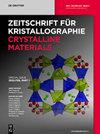具有宽同构取代的微孔骨架极性硅酸盐锗酸盐:(K2.9Cs0.1)(Sc0.7In0.3)[(Si2.95Ge0.05O9]·H2O和(K2.16Cs0.84)Bi[(Si1.5Ge1.5)O9]·H_2O
IF 2.7
4区 材料科学
Q3 CRYSTALLOGRAPHY
Zeitschrift Fur Kristallographie-Crystalline Materials
Pub Date : 2023-03-01
DOI:10.1515/zkri-2022-0056
引用次数: 0
摘要
摘要在温和的水热条件下,在多组分体系中合成了新的硅酸盐锗酸盐(K2.9Cs0.1)(Sc0.7In0.3)[(Si2.95Ge0.05O9]·H2O和(K2.16Cs0.84)Bi[(Si0.5Ge0.5)3O9]·H_2O。这些新化合物被归类为亲缘关系密切的K3ScSi3O9·H2O母体结构sp.gr.Pmn21的新代表。将它们的结构和同构特性与它以及早期研究的K1.46Pb1.54Сa[(Ge0.23Si0.77)3O9](ОН)0.54·0.46Н2О进行了比较。硅酸盐锗酸盐与其他已知化合物一起形成了广泛的家族A3M[T3O9]·H2O,a=K,Cs,Ca,Pb;M=Ho、Sc、Lu、Tb、Er、Y、Bi、Pb、In;T=Si,Ge,具有M八面体和T四面体组合的混合微孔骨架。大型碱金属或/和Ca、Pb阳离子填充横截面高达7.3Å的宽骨架通道。由于在通道、四面体和八面体中有广泛的同构取代,预计该族中的离子交换性质。由于极性对称,所有晶体都具有二阶非线性,四种成分的正SHG测试证实了这一点。粉末SHG实验证明了α-石英标准信号量级的中等二次谐波强度。本文章由计算机程序翻译,如有差异,请以英文原文为准。
Microporous framework polar silicate-germanates with a wide isomorphic substitution: (K2.9Cs0.1)(Sc0.7In0.3)[(Si2.95Ge0.05)O9]·H2O and (K2.16Cs0.84)Bi[(Si1.5Ge1.5)O9]·H2O
Abstract New silicate-germanates (K2.9Cs0.1)(Sc0.7In0.3)[(Si2.95Ge0.05)O9]·H2O and (K2.16Cs0.84)Bi[(Si0.5Ge0.5)3O9]·H2O have been synthesized in multi-component systems under mild hydrothermal conditions. The new compounds are classified as new representatives of close related K3ScSi3O9·H2O parent structure, sp. gr. Pmn21. Their structural and isomorphic peculiarities are compared with it as well as with earlier investigated K1.46Pb1.54Сa[(Ge0.23Si0.77)3O9](ОН)0.54·0.46Н2О. Together with other known compounds, silicate-germanates form the extensive family A3M[T3O9]·H2O, A = K, Cs, Ca, Pb; M = Ho, Sc, Lu, Tb, Er, Y, Bi, Pb, In; T = Si, Ge, with a mixed microporous framework combined of M-octahedra and T-tetrahedra. Large alkali metal or/and Ca, Pb cations fill broad framework channels with cross-section up to 7.3 Å. Because of wide isomorphic substitution in the channels, and in tetrahedra and octahedra, ion exchange properties in the family are expected. Due to polar symmetry, all the crystals possess second-order nonlinearity which was confirmed with positive SHG tests for four compositions. Powder SHG experiments demonstrated moderate second harmonic intensities of order of α-quartz standard signals.
求助全文
通过发布文献求助,成功后即可免费获取论文全文。
去求助
来源期刊

Zeitschrift Fur Kristallographie-Crystalline Materials
CRYSTALLOGRAPHY-
CiteScore
2.00
自引率
16.70%
发文量
55
期刊介绍:
Zeitschrift für Kristallographie – Crystalline Materials was founded in 1877 by Paul von Groth and is today one of the world’s oldest scientific journals. It offers a place for researchers to present results of their theoretical experimental crystallographic studies. The journal presents significant results on structures and on properties of organic/inorganic substances with crystalline character, periodically ordered, modulated or quasicrystalline on static and dynamic phenomena applying the various methods of diffraction, spectroscopy and microscopy.
 求助内容:
求助内容: 应助结果提醒方式:
应助结果提醒方式:


